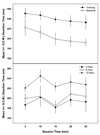Rat psychomotor vigilance task with fast response times using a conditioned lick behavior
- PMID: 20696188
- PMCID: PMC2975873
- DOI: 10.1016/j.bbr.2010.07.041
Rat psychomotor vigilance task with fast response times using a conditioned lick behavior
Abstract
Investigations into the physiological mechanisms of sleep control require an animal psychomotor vigilance task (PVT) with fast response times (<300 ms). Rats provide a good PVT model since whisker stimulation produces a rapid and robust cortical evoked response, and animals can be trained to lick following stimulation. Our prior experiments used deprivation-based approaches to maximize motivation for operant conditioned responses. However, deprivation can influence physiological and neurobehavioral effects. In order to maintain motivation without water deprivation, we conditioned rats for immobilization and head restraint, then trained them to lick for a 10% sucrose solution in response to whisker stimulation. After approximately 8 training sessions, animals produced greater than 80% correct hits to the stimulus. Over the course of training, reaction times became faster and correct hits increased. Performance in the PVT was examined after 3, 6 and 12 h of sleep deprivation achieved by gentle handling. A significant decrease in percent correct hits occurred following 6 and 12 h of sleep deprivation and reaction times increased significantly following 12 h of sleep deprivation. While behaviorally the animals appeared to be awake, we observed significant increases in EEG delta power prior to misses. The rat PVT with fast response times allows investigation of sleep deprivation effects, time-on-task and pharmacological agents. Fast response times also allow closer parallel studies to ongoing human protocols.
Copyright © 2010 Elsevier B.V. All rights reserved.
Figures









Similar articles
-
Sleep deprivation and time-on-task performance decrement in the rat psychomotor vigilance task.Sleep. 2015 Mar 1;38(3):445-51. doi: 10.5665/sleep.4506. Sleep. 2015. PMID: 25515099 Free PMC article.
-
Sleep deprivation enhances inter-stimulus interval effect on vigilant attention performance.Sleep. 2018 Dec 1;41(12):zsy189. doi: 10.1093/sleep/zsy189. Sleep. 2018. PMID: 30265364 Free PMC article.
-
Topographic electroencephalogram changes associated with psychomotor vigilance task performance after sleep deprivation.Sleep Med. 2014 Sep;15(9):1132-9. doi: 10.1016/j.sleep.2014.04.022. Epub 2014 Jun 11. Sleep Med. 2014. PMID: 25087194
-
Psychomotor vigilance task performance during and following chronic sleep restriction in rats.Sleep. 2015 Apr 1;38(4):515-28. doi: 10.5665/sleep.4562. Sleep. 2015. PMID: 25515100 Free PMC article.
-
Sleep deprivation and vigilant attention.Ann N Y Acad Sci. 2008;1129:305-22. doi: 10.1196/annals.1417.002. Ann N Y Acad Sci. 2008. PMID: 18591490 Review.
Cited by
-
Deconstructing and reconstructing cognitive performance in sleep deprivation.Sleep Med Rev. 2013 Jun;17(3):215-25. doi: 10.1016/j.smrv.2012.06.007. Epub 2012 Aug 9. Sleep Med Rev. 2013. PMID: 22884948 Free PMC article. Review.
-
Sleep and Cytokines.Sleep Med Clin. 2012 Sep;7(3):517-527. doi: 10.1016/j.jsmc.2012.06.006. Sleep Med Clin. 2012. PMID: 25177229 Free PMC article. No abstract available.
-
Psychophysical detection and learning in freely behaving rats: a probabilistic dynamical model for operant conditioning.J Comput Neurosci. 2020 Aug;48(3):333-353. doi: 10.1007/s10827-020-00751-8. Epub 2020 Jul 8. J Comput Neurosci. 2020. PMID: 32643083
-
Sleep deprivation and neurobehavioral dynamics.Curr Opin Neurobiol. 2013 Oct;23(5):854-63. doi: 10.1016/j.conb.2013.02.008. Epub 2013 Mar 20. Curr Opin Neurobiol. 2013. PMID: 23523374 Free PMC article. Review.
-
Performance on the mouse vibration actuating search task is compromised by sleep deprivation.J Neurophysiol. 2020 Feb 1;123(2):600-607. doi: 10.1152/jn.00826.2018. Epub 2019 Dec 31. J Neurophysiol. 2020. PMID: 31891527 Free PMC article.
References
-
- Ahissar E, Knutsen PM. Object localization with whiskers. Biol. Cybern. 2008;98:449–458. - PubMed
-
- Balkin TJ, Bliese PD, Belenky G, Sing H, Thorne DR, Thomas M, Redmond DP, Russo M, Wesensten NJ. Comparative utility of instruments for monitoring sleepiness-related performance decrements in the operational environment. J. Sleep Res. 2004;13:219–227. - PubMed
Publication types
MeSH terms
Grants and funding
LinkOut - more resources
Full Text Sources

